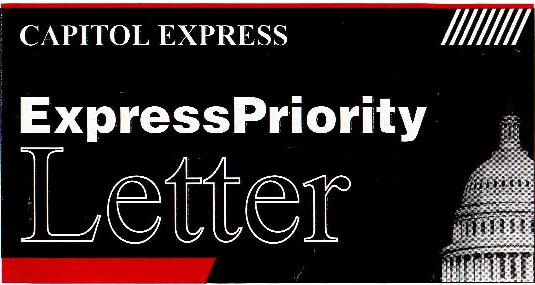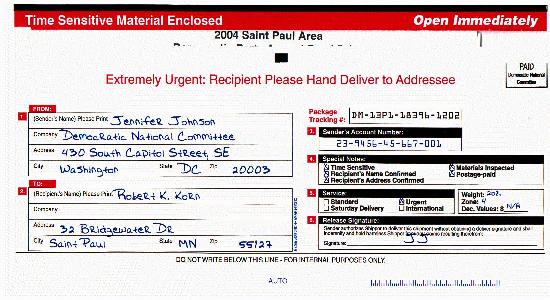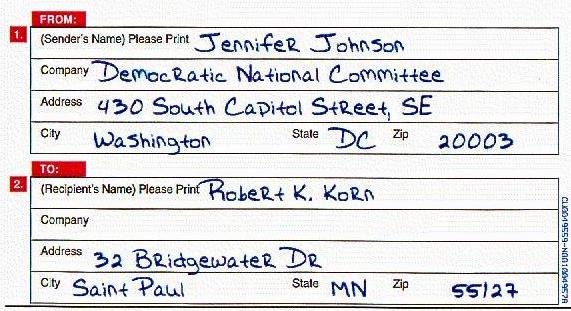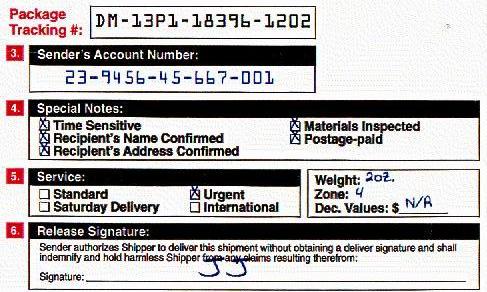Deception in Bulk Mail
A Close Examination of an Actual Case
Senders of "junk mail" will often go to considerable lengths to get you to open their mail or trick you into thinking it is important. I received the item shown below in the U.S. Mail in late December, 2003. It was a large (11 1/2 " by 6") heavy glossy envelope with a perforated strip that you pull to open it.


This clearly is intended to look like it came from an express delivery company like Federal Express, but the fact is that it was delivered by U.S. Mail at a bulk postage rate.
Inside was a rather typical letter asking for a donation with a return envelope (you must supply your own postage).
It the number of deceptions used in this one piece of mail is amazing. Let's go through some of them:
Capitol Express
On the front we see the name "Capitol Express" as if this were the name of an express mail service, and "ExpressPriority Letter" as if this were one of the services they offer. This is meaningless. It was delivered by the U.S. Postal Service.
Time Sensitive?
Some mail is time sensitive, such as the announcement of an upcoming event like a meeting or a sale. If it is not opened soon enough, it will be too late. This is not the case for this item, which is a request for a donation by a political party when the next election is more than ten months away. The senders have probably found that if mail isn't opened quickly it is more likely to be ignored, so they try to increase the sense of urgency with this deceptive message.
Hand Deliver?
"Extremely Urgent" is, of course, absurd. "Recipient Please Hand Deliver to Addressee" doesn't make a whole lot of sense - obviously no employee of "Capitol Express" is going to hand deliver this - but it serves to reinforce the sense of urgency.
Phony hand written label

This is the most entertaining part of the mailing. We see what looks like a handwritten address and return address. I can just picture the volunteer who is exhausted after hand printing a huge number of these addresses! A careful examination shows that this printing is a computer font. Check the lower case "R" which is written like a capital "R" but smaller. It appears in eight places in both the address and the return address. All eight cases are identical. The same is true for every other duplicated character, letter or number. A computers printed this and probably millions of others from mailing list in a data base.
The color of the ink is blue, not the black normally used by computer printers, which further enhances the illusion of hand printing. I've seen even more sophisticated computer fonts that use two samples of each letter apparently randomly chosen in each use in order to disguise the repetition. Although they used the same font for the return address, this wasn't necessary since it could be written once by hand and duplicated on every envelope. Of course it would cost far to much to write each of the recipient's addresses by hand.
Even the FROM and TO boxes are entirely unnecessary, but are included as part of the express delivery deception.
The reason for faking a handwritten address is probably to give the recipient the illusion that special effort has been used on his or her behalf, slightly increasing a sense of obligation to contribute. It also disguises the fact that this same mailing has been sent to thousands or millions of other people. I'm likely to feel my donation is more important if I don't think a huge number of other people were also on the list.
More deceptions

Package Tracking #: There is obviously no tracking for this "package". It was sent by U.S. Mail. This has to be an entirely phony number.
Sender's Account Number: There is no reason for the sender to have any account number, at least not one that would be on the envelope.
Special Notes: Out of the five boxes checked, the only one likely to be true is that the postage was paid. Certainly nobody is going to spend the time to inspect or confirm anything about this automatically printed and assembled mailing.
Service: The only thing checked here is "Urgent", which of course is not something the Post Office pays attention to.
Weight: Although it says 2 oz., I weighed the package with the contents inside and it came to 0.95 oz. It might have weight a tiny bit more when the perforated opening strip was still attached, but certainly it was kept under 1 oz. or else a higher postal rate would have had to be paid.
Release Signature: Says that no signature will be required by the recipient. This is obviously irrelevant for a bulk mail item.
Do Not Write?
Here's one last irrelevant statement to make this look like it's from an express mail service. Whose "internal purpose" would this space be used for? Certainly not "Capitol Express" or the DNC. The United States Post Office obviously doesn't use it for anything. There is no conceivable "internal purpose" this could be used for.
An Unusual Case?
I picked this item because it had so many different phony features, but quite frankly, I, and probably you, get mail like this all the time. Sometimes it is disguised to look like an official government document or an envelope containing a check or something with special legal implications. Such items may come from car dealers, credit card companies, or companies promoting vacations properties. They may say "Registered Documents Enclosed" which means nothing in particular, or that there is a $2000 fine for tampering or impeding delivery, which is no doubt just the standard penalty for tampering with any U.S. Mail.I don't want to imply the Democratic National Committee is any worse than any other organization. I assume the Republicans send out the same nonsense, but I don't happen to be on their mailing list. Most likely these organizations contract with companies that specialize in direct mail advertising, who will prepare mailings like these for anybody who pays them. I have seen the same "handwritten" computer font on mailings from other sources. In fact I saw an ad in an airline magazine that will make up a font based on your own handwriting (you fill in a form with samples for each letter and certain combinations of letters). This would allow you to send form letters to people you know without them looking like form letters.
If we are going to avoid being misled, we have to recognize that the people who send unsolicited mail will deceive us in any way they can get away with. It is never safe to assume honesty when dealing with mail from people we don't know personally.